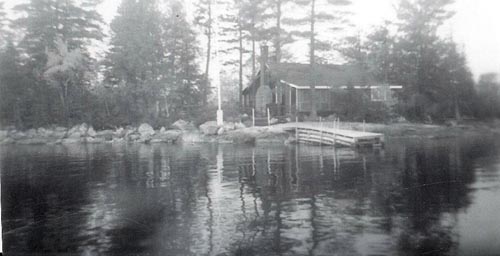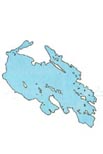|
THE PUTNAM ISLAND
Although we call it Loon Island because we were told that loons once nested there, the official name of our island is Toddís Island. The records do not show how Louis Todd acquired the island, but the late E. B. Davis, the attorney, told me that a fishing camp had been erected there in the early 1900s. The camp had fallen down, and Davis told me that when he was a youth and stayed at the Foster Higgins camp they would row over to Toddís to pick the abundant high bush blueberries. After Louis Todd died, the island went to his sister, Louise Todd, and then to William Beard, who owned several islands and much shore property for which he granted easement to the Moosehorn. From Beard the island and some shore property went to Leonard Watson, and finally in 1953 to William Dwight and Margaret Crane of New York City.
Mr. Crane had been headmaster of a preparatory school for boys and had retired. Mrs. Crane was related to Sam Graham, and it was probably through him that the Cranes came to Meddybemps. The Cranes got Cecil Ward to build their camp. She had an interest in interior decoration, which is still shown in the pecky cypress wood chosen for the walls and the fireplace with granite from Canada. Mr. Crane had his own ideas, too. For example, he insisted that Cecil build the boathouse in the lagoon. However, Cecil told me that he knew that the lagoon was too rocky and that the lake level would fall in late summer, so he didnít spike the boathouse down. He was right, and that winter he dragged the boathouse over the ice to its present location. The Cranes loved their camp, and it was a time of great parties for the Graham clan. The Grahams, whom we later met, had a red-coated butler named Gales. They entertained royally, though our children still remember Mrs. Graham as being rather sparing when she once offered to buy them a five-cent ice cream cone--but only one dip! Iím not sure why the Cranes decided to sell their camp, but Iíve been told that he was noted for having hit every rock in the lake. Whatever the case, we were most fortunate to learn through Elwood Jensen that the island was for sale.
If you lived in Florida in 1962 during the Cuban missile crisis, it seemed like no time to buy a summer home in Maine. The troop trains were rolling past Gainesville, hundreds of military planes flew overhead heading south almost every day. We practiced bomb shelter drills in the basement of the hospital and medical school, and friends of ours built a bomb shelter. In these circumstances I was reluctant to make the decision, but Dorothy was adamant and for that I bless her to this day. I met Mr. Crane in their vast apartment overlooking Central Park, and we concluded the deal over a drink at the Harvard Club.
 |
So, in mid-June of 1963, despite the expected black flies and mosquitoes and the lack of Interstates, we made our first long trip to Maine slowing to 20 mph through the speed traps of Georgia. It must have been 4-5 days before we saw the stately elms that then lined the road in Meddybemps, but it was worth it. We swam, and fished, and boated, and set about to explore and make friends. With Cecilís help we learned how to run the camp with its unfamiliar kerosene and gas lamps and the rusty Briggs and Stratton motor for the water pump. The bass were bigger in those days--and I have photos to prove it, and Lottie Lombardís homemade pies were great, as were the friends we made. In those days there was no electricity on the island and no phone. We pumped water from the lake with the rusty old gasoline motor that frequently broke down. However, the camp had come fully and beautifully furnished with hickory furniture, original paintings and old prints and old Navaho rugs (most since distributed among the family because of concern about theft).
Not all was rosy on the lake. There was the constant concern about smoke and pollution from the Georgia Pacific mill in Woodland. Many summers the lake level was low because of excessive outflow from Harry Smith's dam. I well remember the summer the level went down four or five feet. We had a dock built on stone cribs, and the water dropped to less than a foot above the bottom of the cribs exposing the timbers to dry rot in the air. That winter the ice destroyed the cribs and moved the dock to a nearby island, so we had to have a makeshift floating log dock for years afterwards. Concerns such as these led to the founding of the Lake Meddybemps Association, for which many of us served as officers and directors over the years.
We hesitated to modernize, but safety considerations and the need to communicate with my laboratory overcame our desire to retain a somewhat primitive life style. Our friends on other islands and the Waldrons on their headland had similar concerns and joined with us to form MUD (Meddybemps Utility Distribution, a six-member nonprofit corporation). MUD purchased a large float and with the help of Lloyd Kelley we had a telephone cable laid from the mainland. As an added bonus we were able to purchase the float from MUD to replace our front dock, which had washed away.
Some years later the members of MUD, tired of flaming kerosene lamps, hot gas lights, ancient gas refrigerators and cranky water pumps decided to bring in electricity. This was no small inexpensive venture, for it involved laying cables on the lake bottom as well as wiring the camps. We contracted with an artful electrician now known to us as Wayward Hayward to undertake the job. The rest of this story is better not told. However, in time we had electricity, lighting, and power for which we are most grateful as our years advance. Later MUD deeded the system to the Eastern Maine Electrical Cooperative, but we still must pay rental for the lake bottom to the State of Maine.
Lasting friendships were made on the lake. Thinking of them one is reminded of those who have passed on, most having returned to summers on the lake even in poor health almost to their dying day. To name just a few--the elder Bloomhardts, Mary Jensen, the Knieps, Dottie and Bob Holloway, Lloyd Kelly, and my own Dorothy.
Besides our friends on the lake, we all owe much to those in the village who have helped and befriended us. Again, just to name a few--Cecil and Helen Ward, the Palmeters, the Ketchens, and Paula the Postmaster, Clayton Sawyer, our caretaker for many years, and his wife Thursa, and the Skinners, caretakers for many on the lake. Thoughts such as the above evoke fond memories and can only strengthen our love and lovalty for Lake Meddybemps.
Submitted by Frank Putnahm per eMail March 2004
|
